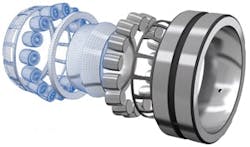Spinning into the future: Smarter management of rotating equipment
It has been estimated that by 2020, the number of industrial machines connected via the internet will exceed five billion. Smart machines and machine-to-machine connectivity hold the promise of raising manufacturing excellence to new levels while creating opportunities to improve maintenance decisions and influence machinery performance.
In this context, Industry 4.0 is creating a foundation for realizing significant improvements in the performance and reliability of rotating equipment. This revolution encompasses digitalization of machinery information, performance data, and condition data and how that data is used.
Digitalization encapsulates the industrial internet of things (IIoT), edge computing, Big Data lakes, cloud computing, and subject matter analytics – all collected and connected to allow professionals to make collaborative business decisions virtually anytime and anywhere.
Real-time comparison and trending
The process starts with gaining access to data that can be gathered from many sources. While some operational and mechanical data are still collected manually, sensors for the job have become relatively less expensive, making automatic collection of real-time operational and condition data increasingly feasible. With interconnectivity made possible among systems across an enterprise, more machine data can be acquired regarding repair history, past failures, past preventive maintenance, manufacturer recommendations, compliance with maintenance procedures, and other factors that influence machinery reliability.
It can be extremely useful to learn, for example, the status of wear components such as filters or bushings or when and how a machine was last lubricated or aligned. Seamless connectivity among smart devices can allow sharing of data about performance, condition, and maintenance noncompliance, particularly when organized in “dashboards.” Collection of such data enables cross-referencing and establishes a foundation for the data analytics process.
The rich data connection, analysis, and sharing that’s allowed by digitalization means that culprits for expected equipment failures can be designed out entirely. Source: SKF
Shrinking technology costs additionally are making “edge computing” possible – pushing the analytics process closer to machines, initiating filtering, and sorting and organizing data. This results in what’s referred to as “smart” data – the most significant and pertinent data related to a specific performance issue – and it drives first-pass corrective actions.
Many leading enterprises across industries have begun to embrace the assorted opportunities unfolding from the IIoT and have invested significantly in digitalization resources and structure-enabling collaboration.
Identifying failure modes and fixes
Efforts associated with data analytics are concentrated on developing more-efficient and effective maintenance processes and business decisions involving rotating equipment.
Traditionally and before the optimization of machine-learning algorithms, data analysis mostly has been the domain of subject-matter experts. With problems detected from analytics, subject matter experts serve to identify corrective actions that can eliminate and/or avoid machinery failures. In the case of rotating machinery performance, most analytic efforts have been focused on improving automation and the effectiveness of root-cause diagnostics to ultimately avoid unplanned machine downtime and mitigate risks associated with failures. Much rotating machinery reliability expertise has been based on data and knowledge obtained from reliability-centered maintenance studies or similar materials, which then have been compared with current practices.
With the availability of more data and collaborative analytics led by subject-matter experts, current efforts are focused on improving prognostics evaluation, extending machinery life cycle, and prolonging run time by managing operations-induced variables.
When a potential equipment failure has been identified, ideally the next step is to calculate the amount of time before the failure is likely to occur – and, in the case of business-critical assets, whether the impending failure can be managed or delayed. Can run time of an asset be extended, for example, so that repairs can be aligned with a planned shutdown?
The value in pairing the benefits of data with expertise is significant. For paper manufacturers, correlating condition data, bearing inspection data, and maintenance practice data can eliminate repeat failures resulting from ineffective lubrication practices. Similarly, for steel producers, correlation of condition, failure, and design data along with environmentally induced variables can be used to decrease water contamination failures and improve roll quality yield by introducing more appropriate seal designs.
Ultimately, with knowledge learned from one application and shared with the equipment manufacturer or service shops, the culprits for expected failures can be designed out entirely or equipment can be modified so that the usual cause for failure will not become problematic again – in turn, reducing life cycle costs and extending asset life.
In the outcome-oriented services business model, a manufacturer, rather than merely selling a product, strategically focuses on and stands behind a product’s capability.
Automating decision-making processes
While subject-matter experts have been on the front lines in making educated decisions, automation of diagnostic and prognostic processes is essential to realizing efficiency improvements. The automation process itself can be made more effective through machine learning and creation of user profiles – applying learning-algorithm logic to the management of rotating equipment reliability.
Gaining access to enough of the right data at the right time through machine-learning data analytics will support efficiency improvements in condition-based maintenance tasks. Even more encouraging, automated detection of a bearing failure is on the horizon.
But the supply chain must be in sync, too – challenges truly are enterprise-wide. The process of ordering a replacement bearing – including creating a purchase order and estimating the lead and delivery times while keeping in mind planned shutdown times for the fix – today still involves human intervention.
Automating the supply chain is not far off, however. Eventually, a system monitoring a bearing will place an order for the bearing’s replacement.
With accurate prediction of a failing bearing tied to an automated order system, it will be possible for some forecasts and inventories for bearings to be replaced by actual demand and delivered from the factory floor to customers just in time for the scheduled downtime. This represents unprecedented efficiency.
‘Rotations for life’
The concept of outcome-oriented services, pioneered by GE and Rolls-Royce aircraft engine business units, has gained ground thanks to advances in digitalization, and it has paved the way for a different way of thinking about and doing business.
In the outcome-oriented services business model, a manufacturer, rather than merely selling a product, strategically focuses on and stands behind a product’s capability. In the case of aircraft engines, a customer could purchase what amounts to a performance guarantee for thrust capability. It is this performance requirement and outcome (not the engine itself) that effectively is being sold. This represents an entirely new paradigm in the marketplace and a new way of doing business and meeting customer expectations.
Dave Staples handles strategic industrial sales and services at SKF USA Inc. Contact him at [email protected].
Such a performance-based business model can apply across manufacturing industries.
In the next several years, Industry 4.0 will continue to enhance a platform promoting significant improvements in rotating equipment performance and reliability. Once data is structured and centrally organized and stored, an environment can be fostered where collaboration and partnerships drive improved actions and processes that affect asset performance.
Connectivity to the cloud and the proliferation of mobile devices on the plant floor will carry the digitalization revolution to an even higher level. All hold the promise of promoting informed maintenance decision-making anytime and anywhere – while building a foundation for knowledge-sharing and timely transfer of data to advance day-to-day operations and enhance the productivity and reliability of rotating equipment.



